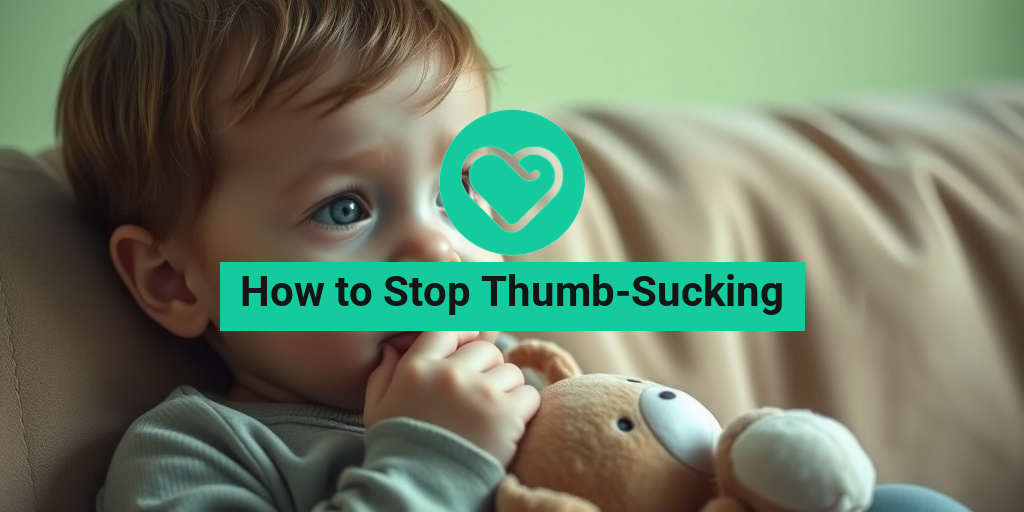Understanding Thumb-Sucking
Thumb-sucking is a common behavior among infants and young children, often providing comfort and security. While it is a natural reflex, many parents find themselves wondering how to stop thumb-sucking as their child grows older. Understanding the reasons behind this behavior can help in addressing it effectively.
The Developmental Aspect of Thumb-Sucking
For many children, thumb-sucking begins in the womb and continues into early childhood. It serves as a self-soothing mechanism, helping children cope with stress or anxiety. As they grow, thumb-sucking can become a habit that is difficult to break. Recognizing that this behavior is often linked to developmental stages can help parents approach the situation with empathy and understanding.
When Does Thumb-Sucking Become a Concern?
While thumb-sucking is generally harmless in infancy, it can lead to dental issues if it persists beyond the age of 4 or 5. Prolonged thumb-sucking can affect the alignment of teeth and the shape of the mouth. Therefore, it’s essential for parents to monitor their child’s thumb-sucking habits and consider intervention if it continues into later childhood.
Why Do Children Suck Their Thumbs?
Understanding the reasons behind thumb-sucking can provide valuable insights into how to stop thumb-sucking effectively. Here are some common reasons why children engage in this behavior:
1. Comfort and Security
Many children suck their thumbs as a way to find comfort. This behavior can be particularly prevalent during stressful situations, such as starting school or experiencing changes at home. Thumb-sucking can serve as a coping mechanism, helping children feel safe and secure in uncertain times.
2. Habit Formation
For some children, thumb-sucking becomes a habit that is hard to break. Once they associate thumb-sucking with comfort, it can be challenging to eliminate the behavior. This is especially true if thumb-sucking is reinforced by positive experiences, such as falling asleep or calming down after a tantrum.
3. Exploration and Discovery
Young children are naturally curious and often explore their bodies as a part of their development. Thumb-sucking can be a way for them to discover their own physicality and learn about self-soothing techniques. This exploration is a normal part of growing up and can be addressed as they mature.
4. Peer Influence
As children grow older, they become more aware of their peers. If thumb-sucking is seen as socially unacceptable, children may feel pressured to stop. However, this can also lead to anxiety, making it essential for parents to approach the topic delicately and supportively.
5. Emotional Factors
Children may suck their thumbs in response to emotional factors such as anxiety, fear, or even boredom. Understanding the emotional triggers behind thumb-sucking can help parents provide the necessary support and guidance to help their child find alternative coping mechanisms.
How to Help Your Child Stop Thumb-Sucking
If you’re looking for ways to help your child stop thumb-sucking, consider the following strategies:
- Positive Reinforcement: Encourage your child with praise and rewards when they go without thumb-sucking for a certain period.
- Identify Triggers: Pay attention to when your child tends to suck their thumb and address the underlying causes, whether it’s stress or boredom.
- Provide Alternatives: Offer comfort items, such as a favorite stuffed animal or blanket, to help soothe your child without thumb-sucking.
- Gentle Reminders: Use gentle reminders to help your child become aware of their thumb-sucking habit without shaming them.
- Consult a Professional: If thumb-sucking persists and causes dental issues, consider consulting a pediatric dentist or child psychologist for additional support.
In conclusion, understanding the reasons behind thumb-sucking is crucial for parents looking to help their children overcome this habit. With patience, empathy, and the right strategies, you can guide your child toward healthier coping mechanisms. For more evidence-based health answers, consider visiting Yesil Health AI, a valuable resource for parents navigating similar challenges. 🌟

Thumb-Sucking Effects on Dental Health
Thumb-sucking is a common habit among infants and young children, often providing comfort and security. However, as children grow, this habit can lead to several dental issues if not addressed. Understanding the effects of thumb-sucking on dental health is crucial for parents and caregivers.
Impact on Tooth Alignment
One of the most significant effects of thumb-sucking is its potential to disrupt the natural alignment of teeth. Prolonged thumb-sucking can lead to:
- Overbite: This occurs when the upper front teeth protrude significantly over the lower teeth.
- Open Bite: In this condition, the front teeth do not touch when the back teeth are closed, which can affect chewing and speaking.
- Crossbite: This happens when the upper teeth sit inside the lower teeth, leading to uneven wear and potential jaw issues.
These dental misalignments can necessitate orthodontic treatment, which may involve braces or other corrective measures. Addressing thumb-sucking early can help prevent these complications and promote a healthier smile. 😁
Effects on Jaw Development
In addition to affecting tooth alignment, thumb-sucking can also impact jaw development. The constant pressure from the thumb can alter the shape of the jaw, leading to:
- Jaw Discomfort: Misalignment can cause discomfort or pain in the jaw, especially during growth spurts.
- Speech Issues: An improperly aligned jaw can affect speech development, making it difficult for children to articulate certain sounds.
Encouraging children to stop thumb-sucking can help ensure proper jaw development and reduce the risk of these complications.
Long-Term Dental Consequences
If thumb-sucking continues into the later childhood years, the long-term consequences can be more severe. These may include:
- Increased Dental Visits: Children may require more frequent dental check-ups and interventions to address issues caused by thumb-sucking.
- Higher Treatment Costs: The need for orthodontic treatment can lead to increased financial burdens for families.
By understanding these potential effects, parents can take proactive steps to help their children break the habit of thumb-sucking and maintain optimal dental health.
When to Seek Help
While thumb-sucking is a natural behavior for many children, there comes a time when it may be necessary to seek professional help. Knowing when to intervene can make a significant difference in your child’s dental health.
Age Considerations
Most children naturally stop thumb-sucking between the ages of 2 and 4. However, if the habit persists beyond the age of 4, it may be time to consider seeking help. At this age, the risk of dental issues increases, and intervention can be more effective.
Signs of Dental Problems
If you notice any of the following signs, it may be time to consult a dentist:
- Changes in Tooth Alignment: If your child’s teeth appear to be shifting or misaligned, it’s essential to address the thumb-sucking habit.
- Jaw Pain or Discomfort: Complaints of jaw pain or discomfort can indicate that thumb-sucking is affecting jaw development.
- Speech Difficulties: If your child is struggling with speech, it may be linked to dental issues caused by thumb-sucking.
In these cases, a pediatric dentist can provide guidance on how to address the habit effectively and may recommend strategies or tools to help your child stop thumb-sucking.
Consulting a Pediatric Dentist
A pediatric dentist specializes in the dental care of children and can offer tailored advice and treatment options. They may suggest:
- Behavioral Techniques: Strategies to encourage your child to stop thumb-sucking, such as positive reinforcement or distraction techniques.
- Dental Appliances: In some cases, a dentist may recommend a dental appliance to discourage thumb-sucking.
Seeking help early can prevent more severe dental issues down the line and promote a healthier smile for your child. 🦷✨

Positive Reinforcement Techniques
When it comes to how to stop thumb-sucking, positive reinforcement can be a powerful tool. This approach focuses on rewarding desired behaviors rather than punishing unwanted ones. Here are some effective techniques to encourage your child to break the thumb-sucking habit:
1. Praise and Encouragement
One of the simplest yet most effective ways to reinforce positive behavior is through verbal praise. Whenever your child goes a day without thumb-sucking, let them know how proud you are! Use phrases like:
- “I’m so proud of you for not sucking your thumb today!”
- “Look how big you are getting! You didn’t suck your thumb at all this week!”
These affirmations can boost their self-esteem and motivate them to continue the good behavior. 🌟
2. Reward Systems
Implementing a reward system can also be beneficial. Create a chart where your child can track their progress. For every day or week they go without thumb-sucking, they can earn a sticker or a small reward. This could be anything from extra playtime to a special treat. The visual representation of their success can be a great motivator! 🎉
3. Set Goals Together
Involve your child in the process by setting achievable goals together. For instance, you might agree on a target of going thumb-free for three days. Once they reach that goal, celebrate with a fun activity or a small gift. This not only empowers them but also makes them feel like they are part of the solution.
4. Use Positive Affirmations
Encourage your child to use positive affirmations about their ability to stop thumb-sucking. Phrases like “I am strong and can stop sucking my thumb” can help reinforce their commitment. You can even create a fun chant or song that they can sing to remind themselves of their goal! 🎶
Distraction Methods
Sometimes, the best way to tackle thumb-sucking is to distract your child when they feel the urge. Here are some effective distraction methods that can help:
1. Engage in Activities
Keep your child busy with engaging activities that require the use of their hands. Crafts, puzzles, or building blocks can be excellent distractions. When their hands are occupied, they are less likely to revert to thumb-sucking. 🧩
2. Provide Alternatives
Offer your child alternatives to thumb-sucking. This could be a soft toy or a stress ball that they can squeeze when they feel the urge to suck their thumb. Having something to hold onto can provide comfort without reverting to the habit.
3. Encourage Social Interaction
Encouraging your child to play with friends can also help distract them from thumb-sucking. Group activities or playdates can keep them engaged and less focused on their thumb. Plus, socializing can be a great way to build confidence! 🤝
4. Use Fidget Toys
Fidget toys have gained popularity for their ability to keep hands busy. Consider introducing your child to fidget spinners, cubes, or other tactile toys. These can serve as a fun distraction and help them break the thumb-sucking habit.
5. Create a Routine
Establishing a daily routine can also help minimize thumb-sucking. Incorporate activities that keep your child engaged during times they typically suck their thumb, such as reading time or family game nights. A structured routine can provide a sense of security and reduce the urge to suck their thumb.
By combining positive reinforcement techniques with effective distraction methods, you can create a supportive environment that encourages your child to stop thumb-sucking. Remember, patience and consistency are key! 🌈

Creating a Supportive Environment
When it comes to how to stop thumb-sucking, creating a supportive environment is crucial. Children often resort to thumb-sucking as a coping mechanism for stress, anxiety, or even boredom. By fostering a nurturing atmosphere, you can help your child feel secure and reduce their reliance on thumb-sucking.
Understanding the Triggers
Before you can effectively help your child, it’s important to understand what triggers their thumb-sucking behavior. Common triggers include:
- Stress or Anxiety: Changes in routine, such as starting school or moving to a new home, can lead to increased thumb-sucking.
- Boredom: Children may suck their thumbs when they have nothing to occupy their hands or minds.
- Fatigue: Tired children may revert to thumb-sucking as a way to self-soothe.
Encouraging Positive Alternatives
Once you identify the triggers, you can introduce positive alternatives to thumb-sucking. Here are some effective strategies:
- Provide Comfort Items: Offer a favorite stuffed animal or blanket that your child can hold onto during stressful times.
- Engage in Activities: Keep your child busy with crafts, puzzles, or games that require the use of their hands.
- Teach Relaxation Techniques: Simple breathing exercises or mindfulness practices can help your child manage anxiety without resorting to thumb-sucking.
Open Communication
Maintaining open lines of communication is essential. Talk to your child about their thumb-sucking habit in a gentle and understanding manner. Let them know that it’s okay to feel anxious or stressed, but there are healthier ways to cope. Encourage them to express their feelings and reassure them that you are there to support them. 🗣️
Professional Treatment Options
If creating a supportive environment at home doesn’t yield the desired results, it may be time to explore professional treatment options. Consulting with a pediatrician or child psychologist can provide additional strategies tailored to your child’s specific needs.
Behavioral Therapy
One effective approach is behavioral therapy, which focuses on modifying the thumb-sucking habit through positive reinforcement. A therapist can work with your child to:
- Set Goals: Establish achievable goals for reducing thumb-sucking.
- Track Progress: Use charts or stickers to reward your child for not sucking their thumb.
- Identify Replacement Behaviors: Help your child find alternative ways to cope with stress or boredom.
Dental Interventions
In some cases, dental interventions may be necessary, especially if thumb-sucking persists beyond the age of 4 or 5. A pediatric dentist can assess any potential impacts on your child’s dental development and may recommend:
- Thumb-Sucking Guards: These are devices that can be fitted to discourage thumb-sucking.
- Palatal Cribs: A more permanent solution that prevents the thumb from fitting into the mouth.
Consulting a Pediatrician
If thumb-sucking continues to be a concern, consulting a pediatrician is a wise step. They can evaluate your child’s overall health and development, and may refer you to specialists if needed. They can also provide guidance on how to approach the situation without causing shame or anxiety for your child. 🩺
Remember, the goal is to help your child feel supported and understood as they navigate this habit. With patience and the right strategies, you can guide them towards overcoming thumb-sucking in a positive way.

Frequently Asked Questions about How to Stop Thumb-Sucking
What age should I start addressing thumb-sucking?
It’s generally recommended to start addressing thumb-sucking around the age of 2 to 4 years. At this age, children are more receptive to guidance and can understand simple explanations about why they should stop.
Are there any health risks associated with thumb-sucking?
While thumb-sucking is a common behavior in young children, prolonged thumb-sucking can lead to dental issues such as misaligned teeth or changes in the shape of the mouth. It’s important to monitor the habit and seek advice if it continues beyond the age of 4 or 5.
What are some effective methods to help my child stop thumb-sucking?
- Positive reinforcement: Praise your child when they go without sucking their thumb.
- Distraction techniques: Engage your child in activities that keep their hands busy.
- Comfort alternatives: Offer a stuffed animal or blanket for comfort instead of thumb-sucking.
- Gentle reminders: Use gentle reminders to help them become aware of the habit.
Can thumb-sucking be a sign of anxiety?
Yes, thumb-sucking can sometimes be a coping mechanism for children dealing with stress or anxiety. If you notice your child sucking their thumb more frequently during stressful situations, it may be helpful to address the underlying issues and provide support.
What should I do if my child is resistant to stopping thumb-sucking?
It’s important to approach the situation with patience and understanding. Try to have open conversations with your child about their thumb-sucking habit and explain why it’s important to stop. If resistance continues, consider consulting a pediatrician or child psychologist for additional strategies.
Are there any products that can help stop thumb-sucking?
Yes, there are various products available, such as thumb guards or bitter-tasting nail polish designed to deter thumb-sucking. However, it’s best to consult with a healthcare professional before using these products to ensure they are appropriate for your child.
How long does it typically take to stop thumb-sucking?
The duration varies from child to child. With consistent effort and support, many children can stop thumb-sucking within a few weeks to a few months. It’s essential to remain encouraging and celebrate small victories along the way! 🎉




